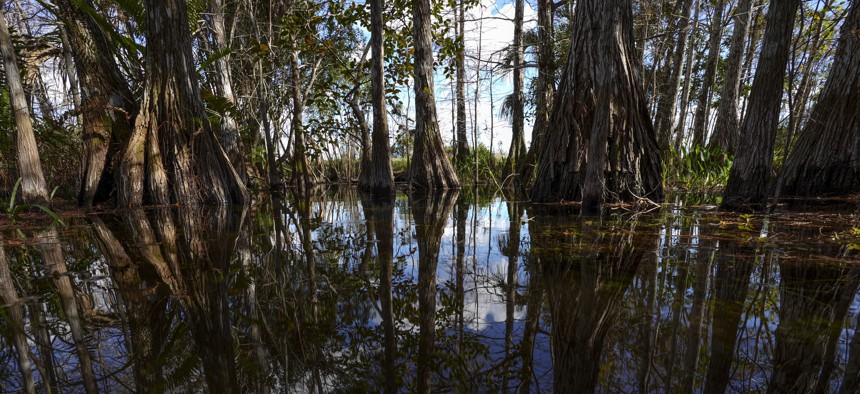
Everglades National Park Washington Post/Getty
6 places where federal employees actually work in swamps
A tour of government-owned wetlands.
It is one of the most enduring metaphors and epithets for Washington, D.C. and the federal bureaucracy: The Swamp. As in, a boggy, messy place that must be drained to expose its slimy inhabitants.
The phrase’s modern usage dates back to Ronald Reagan in 1983, in reference to his ongoing (and not exactly successful) effort to slash the size of government. Given that Washington was built on an actual swamp, the reference has since then proved irresistible to politicians, especially Donald Trump, who literally turned it into a rallying cry.
Of course, D.C. is no longer a real swamp, and most federal employees don’t work there anyway. But some toil in bona fide swamps. Here are six examples:
It’s the granddaddy of U.S. swamps—the largest subtropical wilderness in the country. In fact, it’s world-renowned. Everglades, like several swamps on this list, is officially designated a Wetlands of International Importance. Rangers lead tours of the vast wilderness year-round, but contractors handle much of the load in the slower summer months. The park also employs General Schedule workers to handle such chores as fee collection (a GS-303 position). The park also offers a wide array of internship opportunities.
If you’re planning a visit, rangers warn that this non-metaphorical swamp comes with real-life dangers. Stay at least 15 feet from alligators and crocodiles, they say, and in seemingly related advice, “leave the fur babies at home.”
Okefenokee National Wildlife Refuge
This refuge in Georgia, which encompasses the famed Okefenokee Swamp, is more than 350,000 acres in size, and is home to more than 600 plant species. It is, according to refuge officials, also “world renowned for its amphibian populations,” which include about 15,000 alligators.
As for the humans who work in the swamp, many are volunteers. They handle tasks ranging from visitor services to rebuilding boardwalks and platforms. Some actually reside in the refuge—but for that, you have to supply your own trailer or recreational vehicle.
Great Dismal Swamp National Wildlife Refuge
Once covering more than a million acres in what is now Virginia, the swamp under the protection of the refuge is 113,000 acres in size. It was named by William Byrd II, who was apparently unimpressed with its environs, in 1728. Today, its swamp-working employees are experts in conservation, deploying tools ranging from prescribed fires to wildlife monitoring. Staff also offer a variety of educational programs for visitors.
The Great Dismal Swamp served as a stop on the Underground Railroad, where an estimated 50,000 enslaved people seeking freedom found sanctuary from their pursuers. Some even permanently joined a small community that was established in the swamp.
“Home of Champions” blares the headline atop Congaree’s website. Champion trees, that is, straight from the biggest old growth bottomland hardwood forest in the southeastern United States. The park, in South Carolina’s Midlands region, is a place of great biodiversity. But human employees are apparently at a premium.
“Park rangers and volunteers conduct guided programs throughout the year,” the park notes, “as staffing permits.”
In what may be a long-term solution to that problem, the park appears to be facilitating the development of future federal swampworkers. It encourages young people to join its junior ranger program.
Klamath Marsh National Wildlife Refuge
Metaphorically, this remote Oregon swamp is home to few of the human species known as federal employees. “The visitor center is staffed on a limited basis throughout the year,” refuge officials note, “and during specific field seasons is closed regularly.”
The refuge’s website doesn’t exactly put on the hard sell for visitors. The area is described simply as “primarily wet meadows with some open water wetlands.” But it provides a nice view of the Cascade Mountains. The area suits the Oregon spotted frog just fine. Klamath Marsh is one of the last remaining homes of the endangered species.
Death Valley boasts that it’s the “hottest, driest and lowest” national park. So why does it make this list? Because, as Treehugger notes, it is also home to several swampy areas, including Saratoga Springs, a “marshy, spring-fed wetland [that] is an important home to multiple endemic marine species.”
Death Valley is also the workplace of National Park Service scientists, specifically those of the Mojave Desert Network, which monitors springs at five different parks. Working in the park’s extreme conditions might not sound that appealing, but Death Valley is fully staffed. “No jobs open to the general public are available at this time,” declares the “Work With Us” section of Death Valley’s website.







